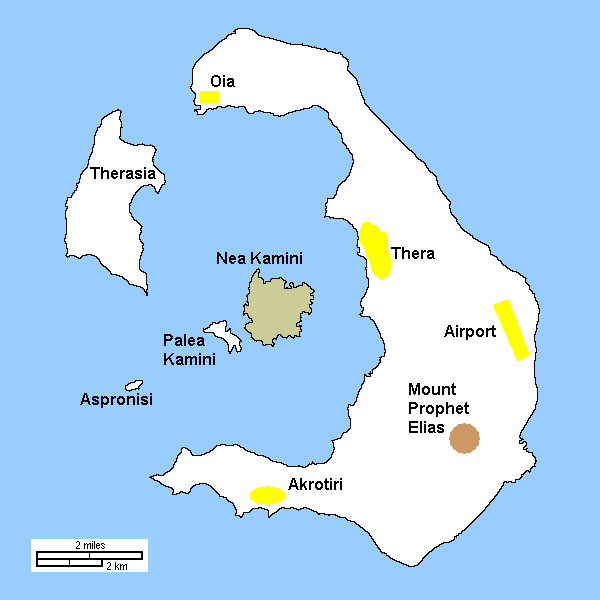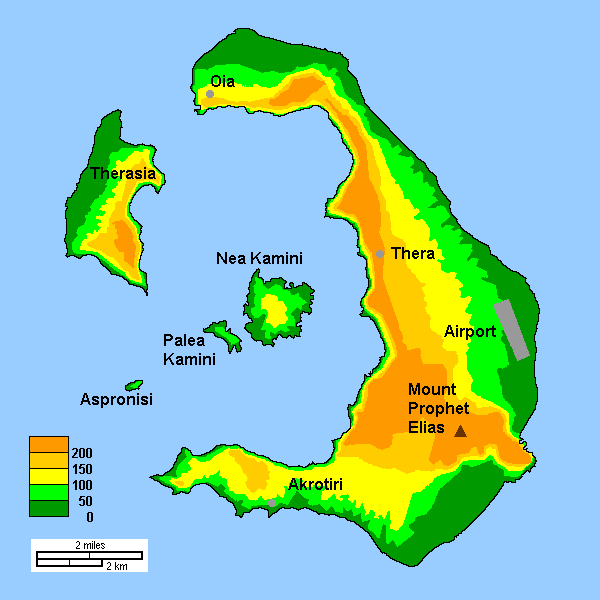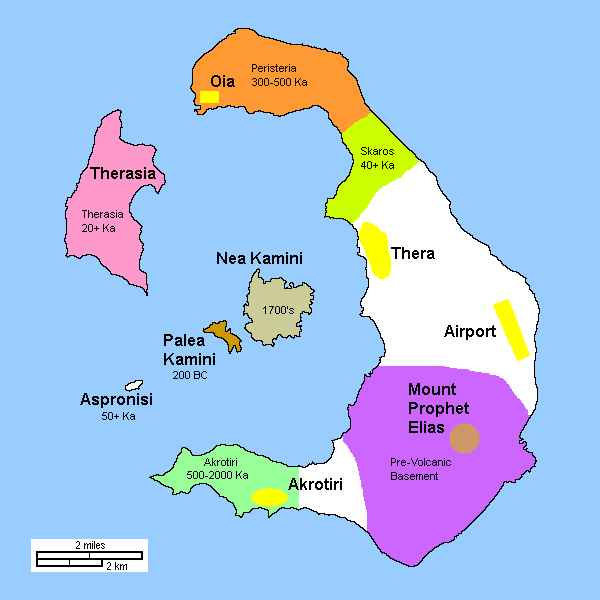Thera (Santorini): Geology
Steven Dutch, Professor Emeritus, Natural and Applied Sciences, University of Wisconsin - Green Bay
Because no geologist gets into Valhalla without seeing this.
Location map of Thera. Thera can refer to the whole caldera, the main town, and the largest island. "Santorini" comes from the former cathedral of Saint Irene, and was applied when the Venetians controlled the Aegean.

Topographic map of Thera.

Geologic map of Thera. Somewhat surprisingly, there are pre-volcanic rocks exposed as well.


Detailed bathymetry and topography of Thera caldera. Reference: https://www.researchgate.net/figure/combined-bathymetric-and-topographic-map-of-Santorini-Caldera-with-15-m-grid-resolution_fig4_260855835. The color scheme is not very well chosen since the sea level contour is between light green and yellow, and the 100-200 and 200-300 meter intervals are barely distinuguishable.. The bathymetry between Nea Kamini and Fira looks intimidating but the summit of the highest submerged hill is still 40 meters deep, beneath the keel of most cruise ships. Although someone did manage to sink a cruise ship by hitting a rock in 2007.
Probable Eruption Sequence

Although shown as a single cone here, Thera was actually a group of overlapping volcanoes and probably had multiple summits.

Cutaway of the volcano, showing the magma chamber, conduit, and previous volcanic deposits.

The eruption begins.

Pyroclastic flows roll down the flanks of the volcano.

With the internal pressure in the magma chamber being vented, the summit begins to collapse. Nobody ever sees this phase directly because it's obscured by ash flows.

Collapsing summit with ash flows removed.

As the eruption continues, the summit collapes still further.

Final collapse. The resulting depression is called a caldera.

Sea water begins pouring in, coming into contact with still-hot rocks.

Flooding of the caldera continues.

Eventually, water deep in the caldera boils and erupts as a huge phreatic eruption. The blast sends a tsunami outward. One puzzling feature is the direction of the openings. The gap between Therasia and Thera opens to the north and the gap around Aspronisi opens to the west. So how could the tsunami do major damage to the Minoan society on Crete, to the south, or account for events in the Biblical book of Exodus, also to the south? Massive ash falls, yes, but tsunamis are a problem.
Also, there's no evidence of deep channels across the main islands, or the ash being scoured away, so the tsunami probably exited through the two main gaps.

After the eruption, smaller eruptions build first, Palea Kamini and later, Nea Kamini.
Ash Deposits
 |
 |
 |
 |
 |
 |
 |
 |
 |
 |
 |
 |
 |
 |
Pre-Volcanic Basement
 |
Dipping metamorphic basement is visible below the horizontal reddish horizons. Some relief is visible on the pre-volcanic surface. |
 |
Basal contact betweem volcanic units and pre-volcanic metamorphic basement near the dock south of Fira town. |
Welded Tuff
 |
A prominent welded tuff layer is visible along the stairs up Thera, where it's just above the large wall. It's about two thirds of the way up the cliff at left, a perspective effect. |
 |
Left: looking along the layer. Below: closeups showing inclusions. |
 |
 |
 |
Left and below: views of the layer. |
 |
 |
 |
Left: The welded tuff is at the top of the photo. |
Buried Topography
The conspicuous feature with the red peak below is a buried hilltop.
 |
 |
 |
Closeup of the turret-like features at top right of the left photo above |
Panorama of Thera town and the cliffs below. The welded tuff layer is a conspicuous dark line about even with the top of the cruise ship. Note that the appearance of the layers changes about at the stern of the ship. The layers become more evenly spaced and less colorful. The point at far left is part of the Skaros eruptive center.


Below: The best place to visualize the former shape of Thera is from the north. the outer slopes of Thera (left) and Therasia (right) define the former base of the volcano. Nea Kamini is visible through the gap. Oia is atop the right end of Thera with Mount Prophet Elias just visible above it.

Possible former appearance. The gap between Thera and Therasia is two kilometers wide, and the cone might have been about that height. Not a Mount Rainier or even Etna, but more like Mount Vesuvius.

Return to Historic Sites Index
Return to Virtual FieldTrips Index
Return to Professor Dutch's Home Page
Created 30 October 2018, Last Update 10 June 2020